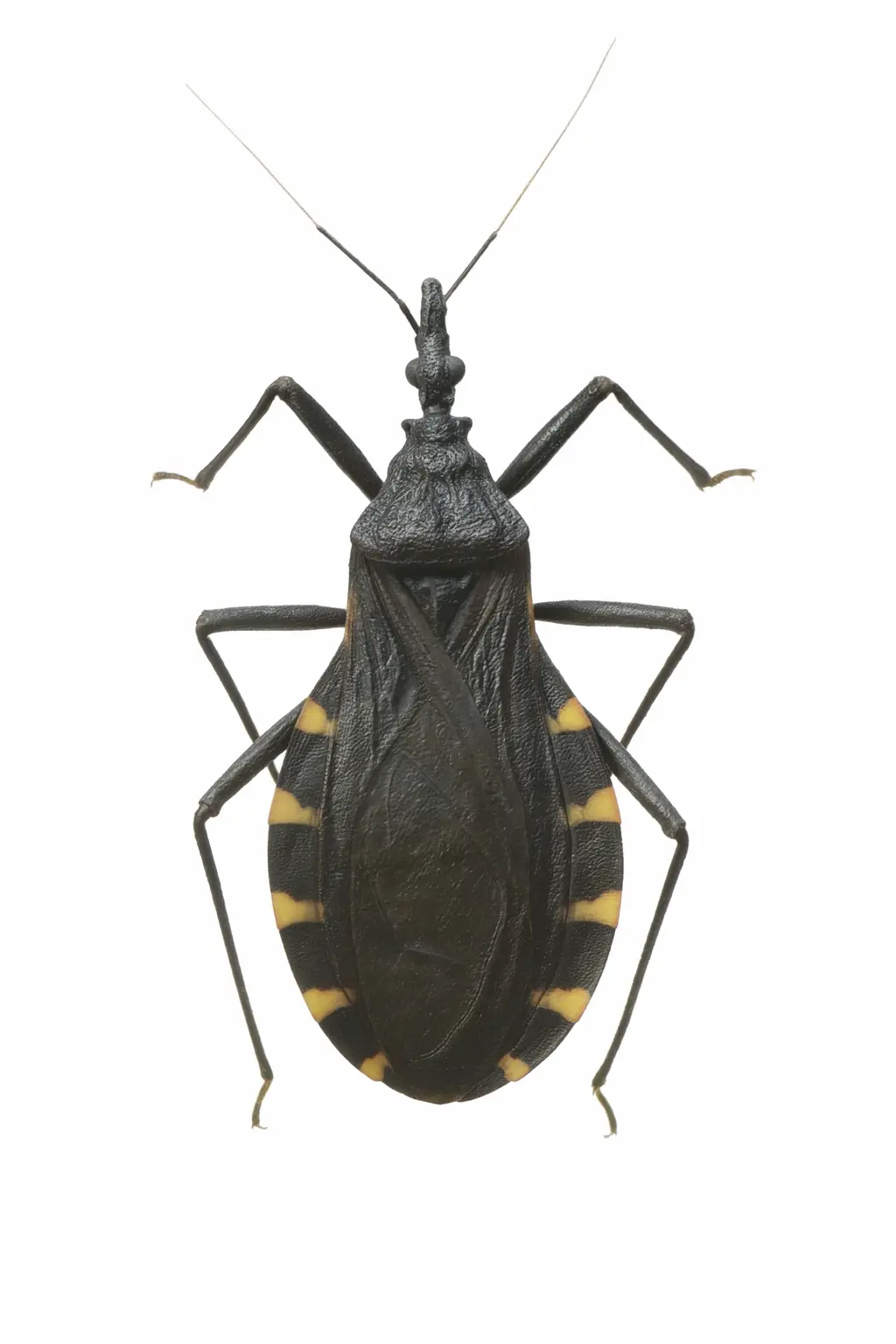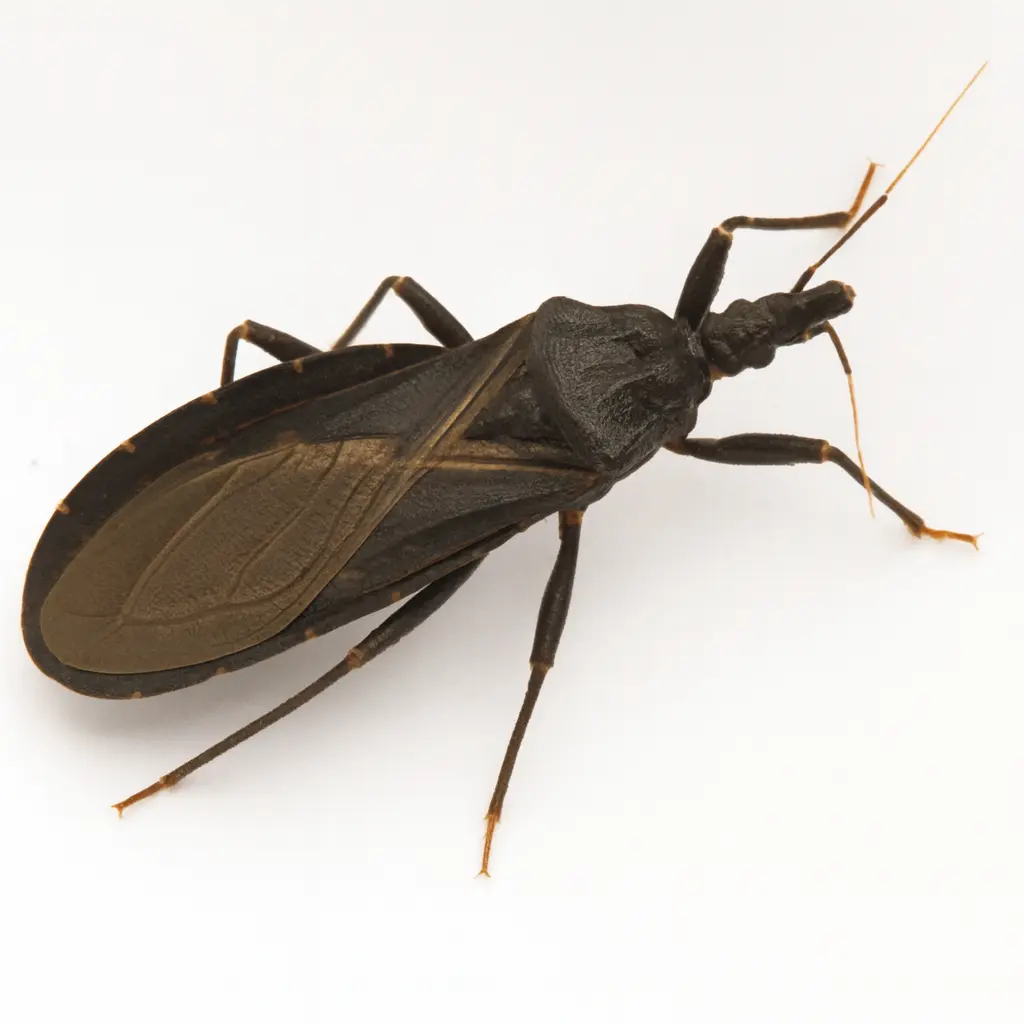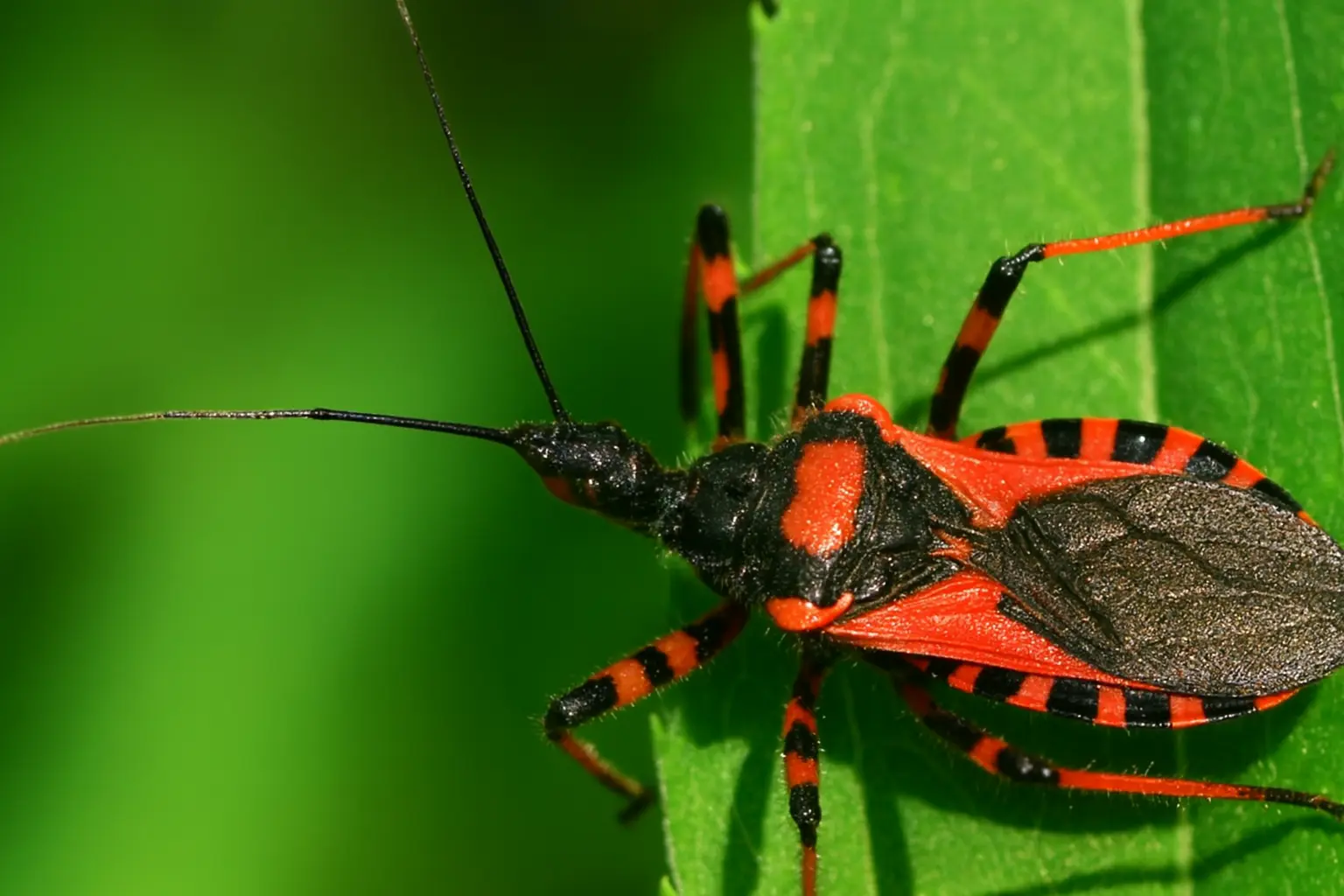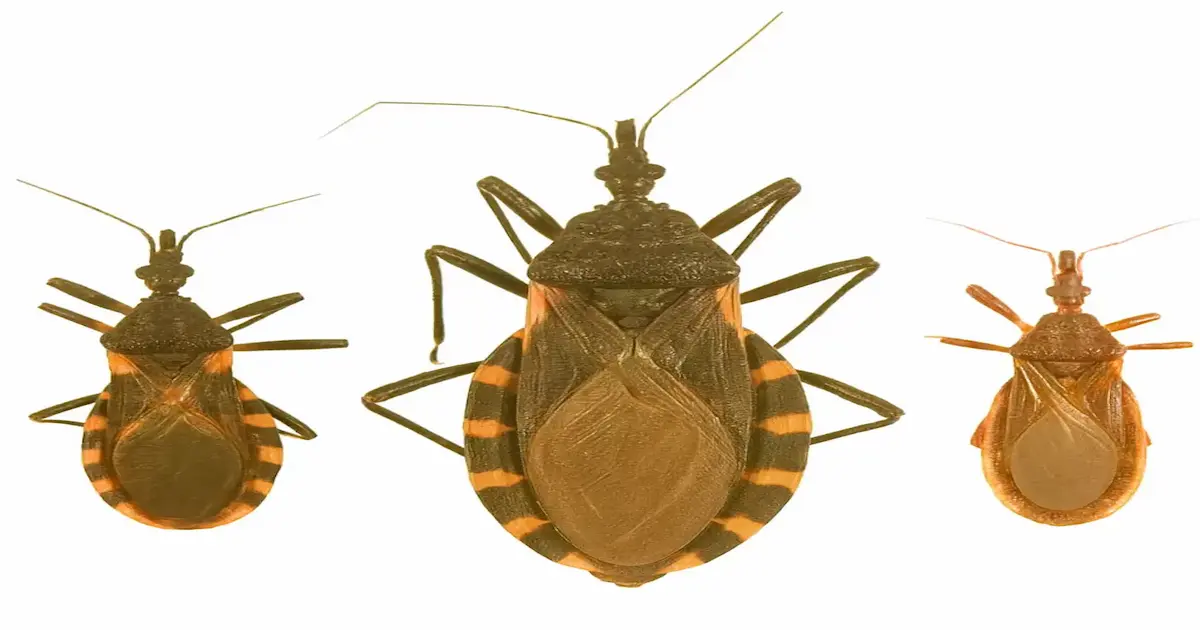The Insect - Kissing Bugs
Kissing bugs, also called "cone-nose bugs," are night-active insects that feed on blood. Adults grow up to an inch long and develop through five immature stages before reaching adulthood. They don't cling like ticks - instead, they feed for several minutes and then crawl away, often without the person noticing. Bites are usually painless at the time but may leave red, itchy welts the next morning, often around the mouth or eyes.
In the United States, kissing bugs have been reported in almost 30 states, though they are more common in the South and Southwest. Texas, Arizona, and New Mexico have the highest variety of species. Studies show that roughly half of all kissing bugs tested carry the parasite responsible for Chagas disease.
The Parasite - Trypanosoma cruzi
The parasite Trypanosoma cruzi is what causes Chagas disease. The parasite isn't in the bug's saliva, so you don't get infected directly from the bite. Instead, the danger comes when the insect leaves feces near the wound, and the parasite enters through rubbing, scratching, or even touching your eyes or mouth. Dogs may also get infected if they eat kissing bugs. Because the parasite can affect both humans and pets, families in Columbus should stay alert. If you notice unusual bites, or suspect kissing bugs around your home, contact our pest control team in Columbus for a detailed inspection and tailored prevention tips.
Transmission can also happen from mother to baby during pregnancy, through infected blood transfusions, or in rare cases through contaminated food or drink.
How Chagas Disease Affects People
Experts estimate that hundreds of thousands of people in the U.S. are living with Chagas disease, though many don't know it. In the acute phase, which lasts weeks or months, symptoms can include fever, tiredness, rash, loss of appetite, or diarrhea - but sometimes there are no symptoms at all. That makes early diagnosis difficult.
About one in three people later develop the chronic phase, which can appear years after infection. The chronic phase may cause serious heart conditions, digestive problems, or other complications that last for decades if untreated.
Impact on Pets and Wildlife
Kissing bugs don't just feed on people - they also bite dogs and wild animals like raccoons, coyotes, and opossums. Dogs are particularly at risk, and infection may lead to heart disease or sudden death. Many infected dogs show no symptoms, which makes testing important in areas where kissing bugs are common. Wildlife act as reservoirs, keeping the parasite present in the environment. For more background, see this CDC coverage on kissing bugs .
Prevention and Home Protection
The risk of Chagas disease depends on the environment: you need the insect, the parasite, and infected animals nearby. You can lower your risk in Columbus by:
- Sealing gaps around doors, windows, and baseboards to block insect entry.
- Fixing torn window screens and avoiding open doors or windows at night.
- Removing brush piles, wood stacks, or animal nests near your home.
- Turning off unnecessary outdoor lights that attract insects.
- Working with licensed pest control for inspection and integrated pest management (IPM).
"We discovered kissing bugs in our dog's kennel. After sealing cracks and getting professional treatment, the problem stopped and our pets were safe again."
Understanding Chagas Disease - An Overview
Interactions between people, pets, and wildlife sometimes create unexpected health risks. Chagas disease is one of them. The illness is caused by a parasite carried by kissing bugs, nocturnal insects that feed on blood. This connection between ecology, environment, and human health is studied under a field called eco-epidemiology. Researchers across the United States are working to understand how kissing bugs spread, where they are found, and how to reduce risks for families and animals in Columbus.
Kissing Bugs - The Vector Behind Chagas
Adult kissing bugs measure about half an inch to an inch long. They hatch from oval-shaped eggs and pass through five immature stages before becoming adults. Some species live for nearly two years, feeding on blood throughout their lives. Unlike ticks, they don't attach for days - instead, they feed for several minutes at night and then leave the host. Most people don't even feel the bite while it happens.
Kissing bugs are found across North, Central, and South America. In the U.S., they've been documented in 29 states, though they're most common in the South and Southwest. Texas, Arizona, and New Mexico have the highest diversity of species. Studies show that about 50% of the bugs tested are infected with the parasite that causes Chagas disease.

The Parasite - Trypanosoma cruzi
The parasite Trypanosoma cruzi (T. cruzi) is the real cause of Chagas disease. Kissing bugs pick up the parasite when they feed on an infected animal or person. The parasite lives in the bug's intestines and comes out in its feces - not in the saliva. That means the bite itself doesn't transmit the disease. Infection happens when feces are accidentally rubbed into the bite, or into the eyes or mouth. Dogs sometimes get infected simply by eating the insects.
Beyond insect bites, T. cruzi can also spread from mother to baby during pregnancy, through contaminated blood transfusions or organ donations, and in rare cases, through food or drinks contaminated with kissing bug feces.
How Chagas Disease Impacts People
Scientists estimate that at least 300,000 people in the U.S. live with Chagas disease, with some research suggesting the number could be over a million. Many of these cases are linked to people who lived in Central or South America, where the disease is more common, but infections do occur within the U.S., especially in southern states where kissing bugs are more widespread.
The disease has two phases. In the acute phase, which lasts weeks to months, symptoms may include fever, tiredness, headache, body aches, rash, diarrhea, or vomiting. Some people don't notice any symptoms at all, making early detection difficult. Years later, around one in three infected people develop the chronic phase, which can cause heart disease, arrhythmias, heart failure, or digestive problems. Because these symptoms can appear decades later, Chagas disease is often called a "silent killer." If you live in Columbus and want peace of mind about possible risks, reach out through our contact form to get practical advice and schedule a professional check.
Wildlife and Domestic Animals
Kissing bugs feed on a wide variety of animals, and many can carry T. cruzi. In the U.S., common reservoirs include woodrats, raccoons, coyotes, and opossums. Birds and reptiles can't get infected, but they can serve as blood sources for the insects. The presence of wild animals near homes increases the chance of kissing bugs settling nearby.
Dogs are especially vulnerable. Infected dogs may suffer from heart disease, digestive issues, or in some cases sudden death. What makes it more concerning is that many dogs don't show symptoms, making testing essential in high-risk regions. Veterinary labs in Texas and other states already offer blood tests for canine Chagas disease.

The Role of the Environment
The environment around a home strongly influences the risk of Chagas disease. For transmission to occur, you need all three: the insect, the parasite, and nearby infected animals or people. Rural homes, kennels with many dogs, or properties close to wooded areas are at higher risk. Even outdoor lighting can play a role - kissing bugs may fly toward porch lights at night and then crawl into houses.
Steps for Prevention
- Seal cracks around windows, doors, and foundations.
- Repair or replace broken window screens.
- Keep yards clean of brush piles, trash, or animal nests.
- Turn off outdoor lights at night if possible.
- Work with pest control professionals on safe, targeted management.
"In southern Texas, dog kennels often report kissing bugs attracted to the heat and scent of animals. By sealing buildings, using screens, and working with pest experts, owners can reduce infestations and protect their pets."
Key Takeaways for Families in Columbus
While cases of Chagas disease in the U.S. are less common than in Latin America, the risk is real, especially in areas where kissing bugs are present. Awareness is the first line of defense. Recognizing the insects, understanding how the parasite spreads, and taking steps to secure your home are the most effective protections for your family and pets.
What Exactly Is a Kissing Bug?
Kissing bugs, also known as triatomine bugs, belong to the same family as assassin bugs. They are usually dark brown or black, often with orange or red markings along their sides. Adults are about an inch long and capable of flying. They earned their nickname because they tend to bite people on the face, lips, or near the eyes while they sleep.
These insects are common in 21 countries, especially Mexico, Central America, and South America, where they are considered endemic. That means they are present all the time, not just seasonally. In the southern United States, kissing bugs are also found, though in much smaller numbers and usually outdoors rather than inside homes. Concerned about spotting one of these insects in Columbus? Send us a message and we'll help you figure out the safest next steps.
Why Are Kissing Bugs Dangerous?
The bite itself isn't the main problem. The danger comes from the parasite Trypanosoma cruzi, which can cause Chagas disease. Here's how it works:
- The bug feeds on your blood, usually at night.
- While feeding, it may leave feces near the bite site.
- The feces contain the parasite.
- If you scratch the bite or touch your eyes, nose, or mouth, the parasite can enter your body.
Once inside, the parasite may cause mild flu-like symptoms, or sometimes none at all. The tricky part is that 10 to 20 years later, some people develop chronic Chagas disease, which can damage the heart or digestive system. Conditions like heart failure, arrhythmias, or "megacolon" (severe colon enlargement) can appear decades after the initial infection.

Are You at Risk in Columbus?
The risk depends mostly on geography and environment. Globally, about 6-7 million people live with Chagas disease, the vast majority in Latin America. In the United States, recent estimates suggest around 288,000 cases - less than 0.1% of the total population. Most U.S. cases are believed to come from people who were infected in Latin America before moving here, but locally acquired infections have been reported in southern states. You can also read more in this Cleveland Clinic article on kissing bug bites .
Not every kissing bug carries the parasite. Worldwide, roughly 55% of kissing bugs test positive. That means if you encounter one bug in Columbus, the chance of infection is relatively low, but not zero. The risk is much higher in areas where the insect, the parasite, and infected animals are all common.
Importantly, Chagas disease is not contagious. You can't get it directly from another person, except from mother to baby during pregnancy, or through blood transfusions and organ donations if not properly screened.
Kissing Bug Locations in the United States
Kissing bugs are reported across 29 U.S. states, most commonly in the South and Southwest. Confirmed sightings include Texas, Arizona, New Mexico, and even parts of the East Coast. If you live in Columbus, staying informed about kissing bug locations can help you take early steps to protect your home and pets.
Chaga Bug - Another Name for Kissing Bug
Some people refer to kissing bugs as the "chaga bug" because of their connection to Chagas disease. While the name isn't scientifically correct, it has become a popular search term online. No matter what you call them, these insects can spread the parasite Trypanosoma cruzi, so prevention is essential.
Are Kissing Bugs Endemic?
In parts of Latin America, kissing bugs are considered endemic, meaning they are present year-round and not just seasonal visitors. In the United States, they are less common, but populations are established in several southern states. Endemic presence increases the long-term risk of Chagas disease in affected regions.
Kissing Bug Sightings in Maryland
While kissing bugs are more common in the Southwest, reports of kissing bug Maryland sightings have also surfaced. These cases are rare, but they highlight the importance of nationwide awareness. Even in states outside the typical range, occasional encounters can occur.
Lissing Bug - Common Misspelling
Online searches sometimes use the term "lissing bug" by mistake. This refers to the same insect: the kissing bug. Including these variations is important for people looking for reliable information, since many may not know the correct spelling.
What To Do If You Get a Kissing Bug Bite
If you suspect a kissing bug bite, acting quickly can reduce the risk of complications. These insects, also called chaga bugs, can transmit Chagas disease through their feces, so treating the wound properly is critical.
- Wash the area immediately with warm, soapy water to remove any possible contamination.
- Avoid scratching the bite. Scratching increases the risk of introducing parasites into your bloodstream.
- Apply a clean, cool compress to reduce swelling and itching around the bite site.
- Use an over-the-counter antihistamine or hydrocortisone cream if itching becomes severe.
- Monitor yourself for symptoms such as fever, fatigue, swollen lymph nodes, or skin rashes.
- If you feel unwell, seek medical care quickly and tell your doctor about the possible exposure to kissing bugs.
- Take a photo of the insect or the bite if possible. This can help doctors or pest experts identify whether it was truly a kissing bug.
- Keep the bug in a sealed container (without crushing it) for professional identification. Crushing can release infectious material.
- Check family members and pets for bites or unusual symptoms, as kissing bugs often bite more than one host in a single night.
- Clean bedding and sleeping areas thoroughly to reduce the risk of repeat exposure.
- Document when and where the bite happened, since this helps both healthcare providers and pest control teams assess local risk.
- Contact local pest control in Columbus if you suspect multiple insects around your home - professional inspection is the safest way to prevent Chagas disease.
In most cases, kissing bug bites resemble mosquito or flea bites, but their position (usually on the face, lips, or eyes) makes them easier to identify. The greater danger lies not in the bite itself, but in the parasite Trypanosoma cruzi that can cause Chagas disease. According to the Cleveland Clinic, early diagnosis and treatment are vital. While there is no vaccine, two prescription medications (benznidazole and nifurtimox) can treat the infection if started soon after exposure.
Families in Columbus should also consider protecting pets, as dogs can develop serious heart problems from Chagas disease. If you suspect that your pet may have been exposed, contact your veterinarian for testing and advice.
When to Contact a Professional
If you discover kissing bugs inside or near your home, don't try to handle the infestation on your own. These insects can hide in cracks, kennels, and woodpiles, making them difficult to eliminate completely. To protect your family and pets in Columbus, reach out to a licensed pest control team for an inspection and targeted prevention plan.
"Despite their sweet-sounding name, kissing bugs are anything but harmless. Awareness, quick response, and professional prevention are the best protections for families."
Protecting Your Family When Traveling
If you travel to Mexico, Central America, or South America, your risk of exposure is higher than in Columbus. In rural areas, kissing bugs often hide in mud walls, thatched roofs, and cracks in housing. To protect yourself:
- Sleep under bed nets treated with insecticide.
- Avoid houses built with mud or straw walls when possible.
- Use insect repellent, especially at night.
- Check luggage and bedding regularly.
- Shake out clothing, shoes, and backpacks before wearing them.
- Keep windows and doors closed at night or ensure they have intact screens.
- Stay in accommodations with well-maintained walls, roofs, and flooring.
- Ask hotels or guest houses if they have pest control programs in place.
- Carry a small travel flashlight to inspect sleeping areas for insects before bed.
- Store food in sealed containers to avoid attracting bugs or other pests.
Even though the bugs are less common in the U.S., staying alert while traveling can reduce your risk of coming home with an unwanted surprise.
